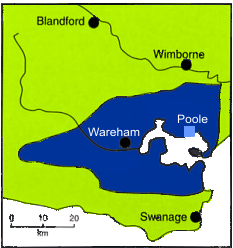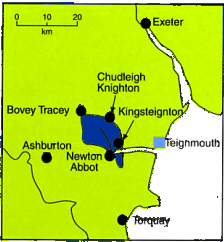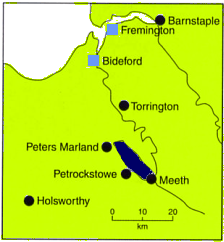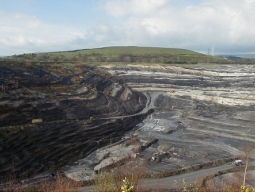How the Ball Clay Deposits Occurred
A rare coincidence of geological conditions was required to form and preserve the ball clay deposits:
1) suitable kaolinite-rich source rocks largely free of iron oxides;
2) erosion of these rocks into fresh or brackish water ‘traps’ for the ultra fine particles before they could be washed out to sea;
3) little subsequent erosion or deep burial of the resultant sedimentary deposit.
The Wareham Basin
 The deposits in Dorset, the Wareham Basin, were formed about 45 million years ago in the Eocene period of the Tertiary era when the climate was sub tropical and wet. Sediments from deeply weathered uplands in Devon and Somerset (that have long since gone) were carried eastwards by a great meandering river. The sediments were deposited in deltas and lagoons spread over an extensive area – about 55 square miles (150 square kms) – near Wareham where the fresh water met the sea-filled Hampshire Basin. The coarser and heavier ‘Bagshot Sands’ settled easily. Vitally, the semi-saline, brackish conditions helped ultra fine clay particles to settle quickly as well, before they could be washed on out to sea. In the sea they would have been so contaminated with salts that their properties would have changed, making them useless for most ceramics.
The deposits in Dorset, the Wareham Basin, were formed about 45 million years ago in the Eocene period of the Tertiary era when the climate was sub tropical and wet. Sediments from deeply weathered uplands in Devon and Somerset (that have long since gone) were carried eastwards by a great meandering river. The sediments were deposited in deltas and lagoons spread over an extensive area – about 55 square miles (150 square kms) – near Wareham where the fresh water met the sea-filled Hampshire Basin. The coarser and heavier ‘Bagshot Sands’ settled easily. Vitally, the semi-saline, brackish conditions helped ultra fine clay particles to settle quickly as well, before they could be washed on out to sea. In the sea they would have been so contaminated with salts that their properties would have changed, making them useless for most ceramics.
Subsequently the great Alpine mountain building forces lifted up the underlying chalk, ending the formation of the Tertiary deposits and creating the Purbeck Hills that now hems in the Wareham deposit along its southern boundary.
The Bovey and Petrockstowe Basins
The two Devon deposits, the Bovey Basin between Newton Abbot and Bovey Tracey in South Devon and the Petrockstowe Basin between Peters Marland and Meeth in North Devon, were formed somewhat later, about 30 million years ago in the Oligocene period of the Tertiary. The hot, wet climatic conditions were continuing, as was the erosion of the region’s deeply weathered uplands. However, now, a massive fault known as the Sticklepath-Lustleigh Fault Zone was re-activated, running north-west to south-east from near Bideford to Torquay.
 In the case of the Bovey Basin, (right),this fault created depressions in which swampy, fresh water lakes formed – and into which the sediment from the surrounding mountains was washed. Rivers carrying sediments from different uplands entered the lakes at different points, dropping first the heavier sands and sandy clays and then the finer clays. Back swamps formed in the quieter areas of the lakes with rafts of floating vegetation and trees (including sequoia) – akin to the Florida Everglades of today. As the vegetation decayed it created organic acids that were essential for ensuring that the ultra fine clay particles that were washed into the basins settled quickly and were not carried on out to sea. Often, fine carbon from the decaying vegetation mixed with the settling clays, helping to give them some of their unique plastic and fluid properties. Ball clays with a high carbon content look brown or black, but the carbon burns off in the potter’s kiln leaving a white or near white ceramic.
In the case of the Bovey Basin, (right),this fault created depressions in which swampy, fresh water lakes formed – and into which the sediment from the surrounding mountains was washed. Rivers carrying sediments from different uplands entered the lakes at different points, dropping first the heavier sands and sandy clays and then the finer clays. Back swamps formed in the quieter areas of the lakes with rafts of floating vegetation and trees (including sequoia) – akin to the Florida Everglades of today. As the vegetation decayed it created organic acids that were essential for ensuring that the ultra fine clay particles that were washed into the basins settled quickly and were not carried on out to sea. Often, fine carbon from the decaying vegetation mixed with the settling clays, helping to give them some of their unique plastic and fluid properties. Ball clays with a high carbon content look brown or black, but the carbon burns off in the potter’s kiln leaving a white or near white ceramic.
In some situations in the Bovey Basin the swamp vegetation was so abundant that it led to the creation of thick beds of carbonaceous lignite. This ‘Bovey Coal’ has at times been used as a brown coal fuel and in horticulture.
 In the case of the Petrockstowe Basin, (right), a river flowed northward through the basin, depositing mainly sandy and silty sediments in the central trough, while the ball clay seams were laid down as overbank deposits in the quieter shelf areas on the northeastern and southern flanks. Lignites are less common, but not unknown.
In the case of the Petrockstowe Basin, (right), a river flowed northward through the basin, depositing mainly sandy and silty sediments in the central trough, while the ball clay seams were laid down as overbank deposits in the quieter shelf areas on the northeastern and southern flanks. Lignites are less common, but not unknown.
As the Sticklepath fault developed over millions of years, the earliest beds of sediment were buried as further movement on the fault allowed sediments to form above them, and they gradually consolidated and formed beds which dipped towards the centre of the basins. The Bovey Basin is over 4,000 feet (1,300 metres) deep and about 7 miles long by 5 miles wide at its widest point (11kms by 8kms). The Petrockstowe Basin is much smaller: about 2,300 feet (700 metres) deep, only 4 ½ miles (7kms) long and less than one mile (1.5kms) wide. The full depth of the Petrockstowe Basin has been core drilled, but only the top 40% of the deepest part of the Bovey Basin has been explored to date.
(Below) Newbridge Pit near Chudleigh Knighton in 2001. The pit shows a sequence of seams of light-coloured clays or sands and dark lignitic clays or lignites deposited in the Bovey Basin.

Sands, Lignites – and Ball Clays!
Some of the beds or ‘seams’ in the three deposits in Devon and Dorset are mainly quartz sand. Some in Devon are almost entirely lignite. Many others contain a mixture of fine clay minerals (particularly kaolinite) with various proportions of quartz and carbon – proportions that vary across the deposit, depending on the proximity to the incoming river and any back swamps. The nature of the clay minerals in the mix depends mainly on the source rock from which they were derived. It was crucial that the deep weathering of the source rocks eliminated almost all iron oxides. These oxides have caused the majority of clay deposits around the world to be coloured red, brown or yellow – as such, they are mainly suitable for making bricks and items such as sewage pipes and terracotta pottery – but not whitewares.
The relatively shallow Wareham deposits are less complex than the others and are largely free of lignite. As a result of erosion, the original deposits, up to about 500 feet (150 metres) deep, are now mostly confined to separate ‘lenses’ several acres in extent in which the clay is about 15 to 50 feet (5 to 15 metres) thick in, at most, four or five rather thick seams under between 10 and 200 feet (3 to 60 metres) of overburden. From the whole deposit about 26 different clay types are produced. The source rocks have given rise to clay minerals with a very fine particle size – giving high green strength – and a pale ivory to buff colour. These properties are ideal for floor and wall tiles, but the clays are also used as components in most other types of ceramic.
In the Petrockstowe Basin the clay minerals were derived from a single source, the Culm Shale uplands of mid Devon. In their resultant high green strength and ivory to buff fired colour these clays typically resemble Wareham clays – and therefore are ideal for the production of tiles and large electrical insulators. However, the Petrockstowe Basin is complex with a large number of clay types, many of which also include carbon. This gives them particular properties making them especially valuable as components in other fine ceramic applications.
In the case of the Bovey Basin, the predominant kaolinite clay mineral was derived from a variety of source rocks in the uplands surrounding the Basin. Where the source was china clay (or ‘kaolin’) from the deeply weathered granite mountains of Dartmoor, the resultant ball clays tend to be like china clay: coarse grained (and therefore not very plastic) but white firing. Where the source of kaolinite was other rocks, the clays tend to be finer grained (and therefore more plastic) but off white to creamy white in colour.
These important variations in clay mineral, combined with the presence of carbon and quartz in certain seams and the very large number of relatively thin beds, have resulted in the Bovey Basin in a huge number of permutations and more than 250 clay types – the largest range in any ball clay deposit.
Traditionally, Bovey Basin ball clays have been divided into two broad groups. Firstly, whiter firing ‘potters” clays, often containing a significant amount of carbon that enhance their plasticity. These were called ‘black’, ‘dark blue’ or ‘light blue’ clays, depending on the colour when dug: they are sometimes regarded as the ‘true’ ball clays. Secondly, less white firing and less plastic ‘stoneware’ clays that contain little or no carbon but an appreciable amount of fine quartz sand (these clays are often referred to as ‘brokes’- because the non-sticky quartz causes them to break up readily).
Today, the different types of clay are blended to obtain the properties ideal for each ceramic application. The technical expertise of the ball clay producer is to identify the properties of each clay seam as they change across the deposit, to understand how the clay will behave when formed and fired as part of a ceramic body, and to blend together different seams to produce a large number of consistent products suitable for each individual customer’s particular manufacturing process.
Widespread uses of ball clay >
For more information about the geology and formation of ball clays, see also the following papers:
The Occurrence of Ball Clays in South West England
Sedimentation in the Bovey Basin (2013)